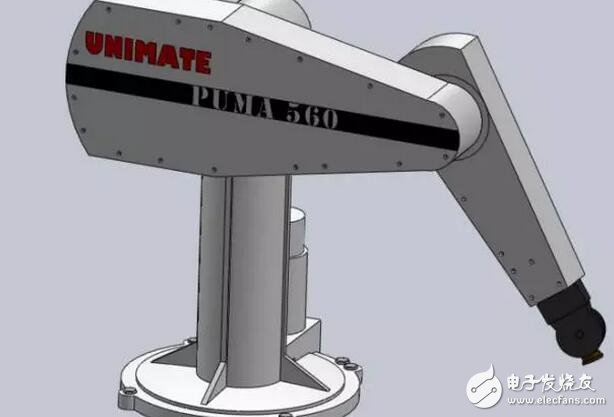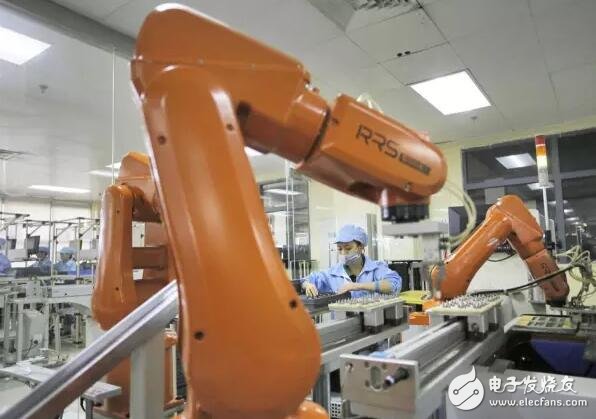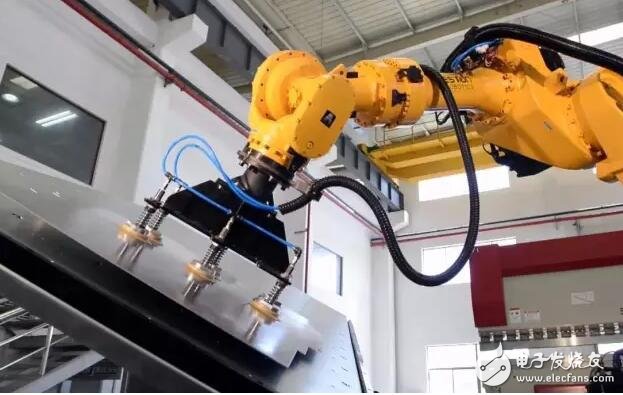Nowadays, the use of industrial robots has begun to become very frequent, and the general public has become more and more aware of industrial robots. Then, we have to think about which direction the future industrial robots should go. With the rise of artificial intelligence, information technology has developed rapidly, which has triggered a new round of technological revolution. When artificial intelligence is combined with industrial robots, intelligent industrial robots are born, and we see the future of the industry from this "new creature."
The future robot market is undoubtedly prosperous. From the past experience and perspective, the definition of robots is very broad and will become more and more extensive. So, let's look back at the early definition of industrial robots. Engel Berger is the father of industrial robots. He once said that if an automatic device only does one thing, then this device can not be called a robot, it can only be called automation, the real robot should have to do each The ability to work differently.

Robots are the most widely used in the automotive industry.
In 1959, the first robot company was established. The earliest robotic applications were used for basic sedimentation work in stamping and forging plants.
In 1969, the first automatic body welding production line was born in the General Motors of the United States. The application of the robot requires a lot of investment, and it is not necessary to install the robot to work. At that time, it took ten years to try to build a welding line built by seventeen robots. However, the good times are not long. Due to the rapid development of new technologies, this auto body welding production line has been “destroyed†12 years later.
In 1982, hydraulic robots began to be applied to the automotive industry for spot welding, but most of the automakers were still using electric robots, and hydraulic robots were not recognized and popularized. Although the early electric robots were very "strong", after a few years, the application of hydraulic robots was popularized in Europe and Japan.
Today, automotive body welding automation has formed a system industry, not a separate robot industry. After more than 30 years of optimization and development, many systems and functions have become quite complicated. It is not easy or difficult for a startup to enter this industry. It must be supported and cultivated by the government to be tentatively entered. In this field, Xinsong robots have spent many years and resources to overcome difficulties, and now they have achieved something that is admirable.
"No standardization" brings opportunities to FoxconnIn 1977, UNIMATION acquired MCOM. MCOM has a robot called PUMA. The original idea of ​​UNIMATION was to use this robot to assemble the production line. That is to say, 40 years ago, robots have been applied to the assembly work of the production line. Today, the robots on the production line are similar in appearance to PUMA, but they have made great progress in technology.
Nowadays, the design, programming and development of robots like PUMA are not as difficult as they used to be. It can be said that robot manufacturers have to be a six-axis robot that is not as complicated as imagined. So, where are the difficulties in laying out line layout robots? In fact, the difficulty is no longer the robot itself, but on the system integration robot (SIR: System Integrate Robot). Integrating different robots on one production line and working together perfectly is the robotic application that the industry needs.

At present, in 3C (computer, communication and consumer electronics-based technology industry), no company can standardize the application of robot systems. In this field, major companies can be described as “eight immortals crossing the sea and showing their magical powersâ€. This also shows that in this area, other companies have the opportunity to participate.
It must be said that the non-standardized production requirements have promoted the development of the entire industry, especially for SME (SMEs), which is a great good thing. However, now that the production line is elastically automated, LME (large companies in the field) still has an absolute advantage. LME is not necessarily the largest company, but it must be a company with leadership in the field. If the LME wants to use the robot, on the one hand, it will be purchased from the robot manufacturer; on the other hand, will it consider building its own robot team? The answer is yes! For example, a manufacturing company like Foxconn has begun to build its own robot for its own production and efficiency improvement. This is no secret.
Robots are a device, a tool, and modern manufacturing needs these tools. Foxconn needs these tools more. So, we do robots ourselves. Currently, Foxconn's robots include welding and handling, and the system has been introduced. In fact, Foxconn is expected to build its own robot within 10 years. Now it has not been used for 10 years, and it has already made some small achievements in the field of polishing. However, this kind of achievement also took a few years to try, and step by step to improve it to achieve this point. We believe that we have the strongest team and application in the world of polishing, although this technology is not open to the outside world. This technology is valuable to Foxconn. At the same time, the related equipment made by using this technology is also the competitive advantage of the manufacturing company. It must be done earlier, faster and better than the competition.
Foxconn is not just pursuing robotsBefore manufacturing a manufacturer's robot, the manufacturer must first consider the life cycle cost of the entire system of the robot. It may be that the price of the robot is relatively cheap when the robot is introduced, but if there is a series of problems such as poor matching, inadequate application, high maintenance cost, and long maintenance period, the cost and loss that the enterprise will face will be greater. Therefore, considering the life cycle cost of a robot is a top priority. If you only build robots and systems, Foxconn can do it. However, if we want to do a large-scale robot application, we need to build a robot ecosystem. Moreover, we must clearly understand that the biggest contribution of robots to industry is to improve the efficiency of the industry. It is not easy to make money on the robot body.

The development of automation is a process, from single machine to the entire production line to achieve automation, and then to production intelligence, and finally establish a smart factory to achieve Industry 4.0. Foxconn is not simply pursuing robots. As products become more sophisticated, functions become more and more abundant, and production cycles become shorter and shorter, our ultimate goal is the object of robot service. Customers must know whether their requirements can be realized at Foxconn. No matter what method is used. In quality science, we have been emphasizing quality, cost, and delivery time to meet these requirements. We only started talking about how to make robot systems. Then, how to do a good job in the robot system must have a craftsman spirit - focus, deep, this is the basic spirit of the robot system.
"Simplification" becomes the benchmark of Industry 4.0The Germans divided the development of industrial automation into four phases: the first phase, at the end of the 18th century, with the advent of steam engine drives, humans began to enter the modern industrial era; the second phase, the early 20th century, based on electricity and energy The emergence of large-scale production has accelerated the development of industrial civilization to a greater extent. In the third stage, in the 1970s, the birth of the first programmable logic controller promoted the development of industrial digitalization; the fourth stage, now In the stage, the information physical integration system has spawned production methods to achieve mobile interconnection.

We focus on the third phase, where the programmable logic controller (PLC), the carrier of electronics and IT technology, further automates the manufacturing process. In fact, the use of CNC machine tools first occurred in the 1940s, and it was rapidly developed in the 1950s and 1960s. Therefore, the birth of PLC in the 1960s was a natural thing. The emergence of steam engines and PLCs generated value for customers. In the 1980s, the customer relationship management system (CRM) divided automatic control into seven small stages. In the 1990s, automatic control was simplified into five small stages. Industry 4.0 was essentially Three small stages: the first small stage is the bottom layer of automation, including robots, equipment and communication; the second small stage is data analysis and monitoring display; the third small stage is the overall control of the factory, including the structure of the whole system, goods The amount of in and out and so on. Of course, from the perspective of the robot, the first small stage is the most important.
Why is Industry 1.0 and Industry 3.0 representative? Because the tools inside them are easy to use. The steam engine invented by Watt actually did two big things: the first one, the automatic control has a sensor inside, which can measure the speed; the second one, the difference between the heating and cooling in the thermodynamics produces the power function. Why did PLC become a benchmark? Because the PLC simplifies the program of the computer control machine. Today, we talk about Industry 4.0, which means we have to reengineer the production process and factory manufacturing.
"Group wisdom" is the futureNow, we have more tools to promote the development of the entire industry, such as the industrial cloud is representative, the cloud carries a lot of wisdom. In April 2016, we worked with IBM at Hanover to transfer information to the cloud via IBM Voice, then dispatched the robot to work, attracting a lot of people to stop watching. This also means that there will be more things to be built in the future, and there are several points here. First, wisdom can be in the robot's ontology or in the cloud; second, the wisdom of the cloud needs a tool that can be easily rendered. Industry 4.0 has not yet formed a specific definition, and people may want to define it repeatedly in the future. However, no matter how it is defined, it is easier to understand and use in the direction of people.

Many people think that artificial intelligence is close to human wisdom, and robots should be equipped with artificial intelligence. Then we must think about how to give industrial robots the wisdom. This kind of wisdom can be called a motive force. What is the driving force? It is possible to perceive the surrounding ecology and make certain actions. This action can be very simple, such as moving items from one location to another. It can also be very complicated, such as writing Chinese characters with a robotic arm, performing fine grinding, and the like. This wisdom is not necessarily much wisdom, it can be called group wisdom. Because the first small stage of Industry 3.0 needs to connect many robotic devices, this is equivalent to forming a group of robots. Although its wisdom is not high, it has certain wisdom. This is the progress of society.
Cruel reality and challengeNowadays, there are many robot companies, including industrial robots, which face cruel reality and challenges.

First, there are too many companies entering the robotics industry. Have there been similar things in the past few decades? The answer is yes. In the 1980s, robots were quite hot in the United States, and suddenly more than 200 robot companies emerged. The current Chinese manufacturing has a greater demand for robots, and there may be 1,000 robot-related companies. What happens after you step in? Price war! Due to the fierce competition, a vicious price war will destroy the healthy and orderly sustainable development of the robot market.
Second, it is necessary to know who the robot is serving. There is no doubt that the service of robots is manufacturing. Then, does the manufacturing industry have a big increase in profits? not at all. Then the money invested and the profits obtained are limited, so we need everyone to reason and judge.
Third, all kinds of robots are developing in fast reading, but their business models are different. For example, service robots and industrial robots are completely different in the business model.
Fourth, the rise of the Internet of Things has brought a big impact on the industry. At the beginning, the hydraulic robot was replaced by an electronically controlled robot. And now the Internet of Things has a huge impact on the robotics industry.
Fifth, the 3G industry is changing rapidly, and some companies will be slow to develop. However, for some outside companies, this is also an opportunity to enter quickly.
Sixth, “Made in China 2025†is to change the manufacturing landscape of China, but it is important to lay a good foundation. We must use the spirit of artisans as the pillar to promote the development of equipment and factories. We must use more software on the basis of hardware, so it is easy to establish the flexibility of functions and systems.
Finally, I will talk about two books written by Louis Caro: one is "Alice's Course" and the other is "The Mirror in the Poetry". In "Alice's History", on the chess board of the chess, the Red Queen took Alice's hand and ran hard to stay in the same place. This teaching is the "Red Queen's Hypothesis". In the biological world, it means to deal with the demise. Then, the meaning of the "red queen hypothesis" in the robot industry is: 1. If you don't run hard, you can't stay in this industry; 2. If you don't run at twice the speed, you will stay in place; If you want to move forward, in addition to running fast, you have to find a way, but also strengthen basic skills. So what is this method? Industrial robots are mainly to help the industry to pursue the progress of efficiency. In the process of this pursuit, some technologies and capabilities have been created. Together with cloud computing and big data technology, a new industry may be established.
The future is an era of intelligent manufacturing, and the Internet of Things will be the technology that will have the greatest impact on the future. On the way to the Internet of Things, we still have a lot of work to do, although there will be many challenges, but I believe that with the joint efforts of all, the future will become the world of intelligent manufacturing and intelligent robots.
Heat Not Burn Sticks In Carton
Blueberry Heat Not Burn,Cool Flavor E Cigarette Stick,E Cigarette Smokers Mojito Flavor,Heat Not Burn Sticks In Carton
Mainstay (Guangdong) biotechnology Co., Ltd. , https://www.heyleme.com